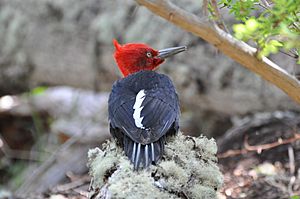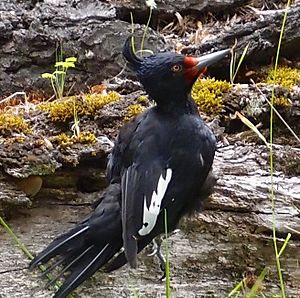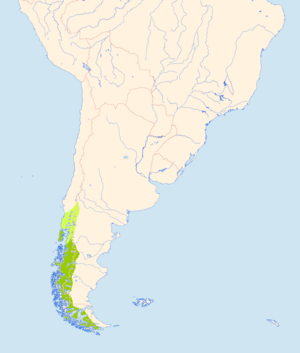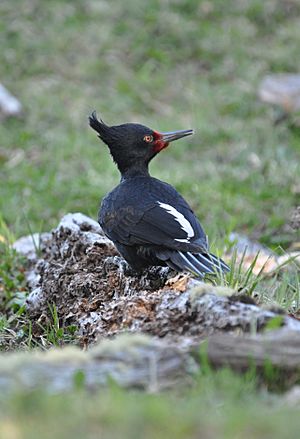Magellanic woodpecker facts for kids
Quick facts for kids Magellanic woodpecker |
|
|---|---|
 |
|
| Male | |
 |
|
| Female | |
| Conservation status | |
| Scientific classification | |
| Genus: |
Campephilus
|
| Species: |
magellanicus
|
 |
|
| Range of Magellanic woodpecker in South America in green, yellow-green and dark blue | |
The Magellanic woodpecker (Campephilus magellanicus) is a very large woodpecker found in southern Chile and southwestern Argentina. These birds live in the same area all year round. This species is the southernmost type of woodpecker in the Campephilus group. This group also includes the famous ivory-billed woodpecker (C. principalis).
Contents
About the Magellanic Woodpecker
The Magellanic woodpecker is about 36 to 45 centimeters (14 to 18 inches) long. That's roughly the length of a school ruler! Male woodpeckers weigh between 312 and 369 grams (11 to 13 ounces). Females are a bit lighter, weighing 276 to 312 grams (9.7 to 11 ounces). It is the biggest woodpecker in South America and one of the largest in the world.
This woodpecker is mostly pure black. It has a white patch on its wings and a gray, chisel-like beak. Male Magellanic woodpeckers have a bright red head and a crest (a tuft of feathers on top). Females have a mostly black head, but they have a small red area near their beak. Young Magellanic woodpeckers look like the females, but their crest is smaller and their feathers are a bit browner. When you see this bird in its natural home, it's easy to recognize!
Magellanic woodpeckers make several different sounds. One common sound is a loud, sharp call that sounds like tsie-yaa or pi-caa. They might make this sound once or many times in a row. Another loud call, often made by pairs, is a gurgling sound like prrr-prr-prrr or weeerr-weeeeerr. Like many woodpeckers, they also make a loud double-knock sound when they drum on trees.
Where They Live (Habitat)
Magellanic woodpeckers live in old Nothofagus and Nothofagus-Austrocedrus forests. These are types of native trees found in South America. They mainly eat grubs (young insects) and adult beetles that live in wood. They also eat spiders. Sometimes, they might eat other things like tree sap and fruits. They have even been seen eating small reptiles, bats, and the eggs or baby birds of other species.
Magellanic Woodpecker Behavior
Magellanic woodpecker families often sleep together in the same tree hole. In one case, five woodpeckers were seen sleeping in a hole about 40 centimeters (16 inches) deep. Breeding pairs are very protective of their territory. They often try to scare away or even attack other woodpeckers of the same species. Sometimes, their older children from previous years help them protect their home. When parents are raising new baby birds, they keep their older children a bit further away.
Diet and Feeding Habits
Magellanic woodpeckers often share their habitat with other woodpeckers like the Chilean flicker and the striped woodpecker. However, they don't compete for food because they are different sizes and prefer different types of food and places to find it. These woodpeckers usually look for food in pairs or small family groups. They are very busy searching for food most of the day. They usually feed on living trees, but they also look for food on dead trees or fallen logs on the ground. After the snow melts in spring, they often search for food on the lower, damp parts of tree trunks. In Tierra del Fuego, they even look for food on dead trees around ponds where beavers have built dams.
Reproduction and Life Cycle
Magellanic woodpeckers breed in the Southern Hemisphere's springtime, from October to January. Both the male and female work together to dig a nest hole in a tree trunk. The nest holes can be at different heights depending on the type of tree and the forest. The nest is usually about 5 to 15 meters (16 to 49 feet) above the ground.
Females lay one to four eggs, but most nests have two eggs. The parents stay together and share all the jobs. They both dig the nest, sit on the eggs to keep them warm, protect their territory from other birds, and raise their young. These adult woodpeckers usually breed only every second year. This is quite unusual for woodpeckers! The eggs hatch after 15 to 17 days. The male woodpecker does most of the egg-sitting at night. Sadly, the younger of the two baby birds sometimes doesn't survive because it doesn't get enough food. The young birds leave the nest when they are 45 to 50 days old.
After being raised by their parents for 2-3 years, and even helping them, young Magellanic woodpeckers become old enough to have their own families. However, they usually don't successfully breed or find a partner until they are 4 to 5 years old.
Ecology and Predators
Several birds of prey are known to hunt Magellanic woodpeckers. These include white-throated hawks, variable hawks, bicolored hawks, and crested caracaras. The caracaras likely only hunt young woodpeckers. When Magellanic woodpeckers are not nesting and they see these predators, they usually become quiet and stay still. But during the nesting season, they often bravely attack these birds of prey to protect their babies.
Conservation Status
Currently, the Magellanic woodpecker is listed as a species of "least concern." This means they are not in immediate danger of disappearing. However, their numbers have been going down in some areas. The loss and breaking up of their forest homes are a growing problem in southern South America. This is a threat to the Magellanic woodpecker. Their living areas have shrunk and become separated because native forests are being cleared. This is especially true in south-central Chile, where they now only live in protected areas or small remaining forest patches.
Changes in the forest after trees are cut down, turning forests into farms for non-native trees, and breaking up forests are the main threats to these birds. Luckily, the Magellanic woodpecker is protected from hunting in both Chile and Argentina. It is rarely, if ever, hunted illegally.
Images for kids
See also
 In Spanish: Carpintero negro para niños
In Spanish: Carpintero negro para niños






